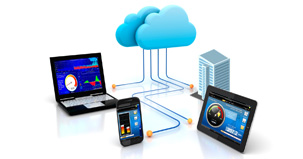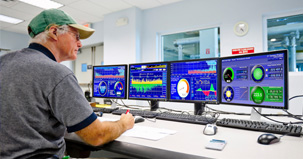- Home
- Smart Data
Smart Data
Actionable intelligence on energy and water use:
- Helps users identify inefficencies, and waste
- Provides real-time feedback on conservation
Right data for the right audience:
- Facility managers identify when and where energy is wasted
- CFO's can track and verify financial savings from initiatives
- Company knows its carbon and water footprint
Related Products
 Information any time, anywhere
Information any time, anywhere - Smart User
Smart User
Smart users leverage real-time data and reduce energy and water use by:
- Continuously identifying opportunities
- Acting on opportunities
- Tracking and verifying savings
- Sustaining savings
Related Products
 Monitor, Manage, Maintain
Monitor, Manage, Maintain - Smart Community
Smart Community
A smart community is one where all stakeholders are engaged in energy and water conservation. A smart community can be achieved by:
- Showing people precisely how much they are using
- Providing real-time feedback on conservation actions
- Effectively communicating efficiency results
Related Products
 Communicate and Conserve
Communicate and Conserve - Smart Grid
Smart Grid
Smart grid, as we define it, is a "green grid", with efficient resource use and the key to a low-carbon future. We help our customers prepare for the smart grid by:
- Engaging users with smart data
- Enabling smart users to increase resource efficiency
- Educating & empowering smart communities
Related Products
 Smart grid and a smarter future
Smart grid and a smarter future - Smart Buildings
Smart Buildings
Smart buildings maximize resource (energy, water, capital) efficiency. These buildings are optimized using energy and water management process with high data visibility which lead to reduced energy and water spending.
- Higher operating income and higher asset values for owners
- Increased productivity for occupants
- Lower carbon footprint for the community
 Resource efficient buildings
Resource efficient buildings
Recent Posts
At Work, One Footprint - Your Carbon Footprint - Can Make a Difference
In your own home, you are the king or queen of the castle. Every light bulb changed and drop of water conserved can make a big difference. But in the workplace, especially when it comes to saving energy, how much can one person do?
You can have an exponential impact on helping your company reduce its carbon footprint – by changing the way your company thinks about and uses energy in the workplace. Small changes can add up to big savings!
You may ask yourself, can one person really make that much of a change? Especially at work? Yes! It starts with one determined person – or a group – who step up and lead the charge. Spring is a great time to make these small changes that can really make a difference – not only in your company’s effort to saving energy, but in saving money, too.
Start with understanding the concept of “carbon footprint.” Technically, it’s defined as “the total set of greenhouse gas (GHG) emissions caused by an organization, event, product or person.” GHG can be emitted through production and consumption of food, fuels and manufactured goods and is expressed in terms of how much carbon dioxide is emitted when energy is expended.
OK, so definitions aside, in the workplace, look at carbon footprint in terms of how the actions of your company leave their “ecological” mark. Simply put, your collective carbon footprint is huge if you are leaving lights on in rooms that aren’t being used, printing emails and other documents that don’t require hard copies, running the air conditioning or heat 24/7 when no one is there to enjoy the comforts, and even failing to discover behind-the-scenes system failures that are wasting energy.
Some companies are trying to offset the energy they use by employing alternative energy systems – such as solar panels or wind energy – to reduce carbon footprint. But even if your company isn’t looking at these types of energy production and conservation strategies, you and your colleagues can make a big difference, by making small changes.
The first step is to measure and monitor how energy is used at work. It’s impossible to determine how much you can save – in energy and money! -- until you realize exactly what you are spending. Take stock of how your company spends its utility dollars.
Review water, gas and electricity bills. Install energy monitors on various pieces of office equipment to find out which are using the most energy. Once you know what’s causing the biggest drain on your system, you can make appropriate changes.
For example, does your copy machine have a sleep mode? Would an automatic lighting system in rooms that are rarely used have a great impact? Consider the bathrooms, kitchen, conference rooms and others to find these hidden savings.
Do you have a programmable thermostat on your HVAC system or is your office being kept cozy warm at night – when no one is there to enjoy it?
By identifying the energy drains in your office, you can make small changes that can have an exponential impact on the company’s utility bills and the environment – your environment. Be the voice of change in your office by creating a plan that allows everyone to do their part. Together, you will cut your company’s carbon footprint. And, even if you are not in a decision-making role at work, you can lobby for change where everyone can benefit.
You’ll all be breathing cleaner, greener air and the people who pay the utility bills will notice the changes quickly, as well.
Originally published in greenbuildingspro.com



